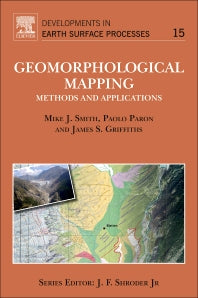Freshly Printed - allow 10 days lead
Couldn't load pickup availability
Geomorphological Mapping
Methods and Applications
Mike J. Smith (Author), James S. Griffiths (Author), Paolo Paron (Edited by)
9780444534460
Hardback, published 1 November 2011
610 pages
22.9 x 15.1 x 3.4 cm, 1.12 kg
"Geomorphological Mapping: Methods and Applications is a practical textbook that is essential reading to students and professional practitioners wishing to embark on a geomorphological project in any discipline. It is the first book of its kind, in that it brings together many topics that are normally dealt with and taught separately. These include the practicalities of completing field mapping, through to data sources and how to interrogate them and process them in a GIS. The diagrams and maps provided as examples are of a high standard. It is easily read and logically arranged, with clear co-operation between the editors and contributors." --Quaternary Science Reviews "This text explains the concepts, characteristics, makers and users of, and trends in, how modern geomorphological mapping can be applied to solve complex problems in land management, including landslide risk assessment, resource location, and changes in landforms. Following a historical overview of trends in field-based geomorphological mapping, Smith (geography, geology, and the environment, Kingston U., UK) and colleagues in the UK and the Netherlands present new digital tools and techniques, e.g., remote sensing, WebGIS, that have resulted in the use of 'non-subjective' mapping in applied research that now informs cartography, geographic information systems, and terrain analysis. The handbook includes international case studies illustrated with diagrams and color plates that exemplify the diverse applications, current limitations and potential of this methodology." --Reference and Research Book News, October 2012
Geomorphological Mapping: a professional handbook of techniques and applications is a new book targeted at academics and practitioners who use, or wish to utilise, geomorphological mapping within their work. Synthesising for the first time an historical perspective to geomorphological mapping, field based and digital tools and techniques for mapping and an extensive array of case studies from academics and professionals active in the area. Those active in geomorphology, engineering geology, reinsurance, Environmental Impact Assessors, and allied areas, will find the text of immense value.
Section 1 – Geomorphological Mapping1. Introduction to Applied Geomorphological Mapping2. Old and New Trends in Geomorphological and Landform Mapping3. Nature and Aims of Geomorphological Mapping4. Makers and Users of Geomorphological Maps5. Geomorphological Contributions to Landslide Risk Assessment: Theory and PracticeSection 2 – Techniques in Applied Geomorphological Mapping6. Geomorphological Field Mapping7. Data Sources8. Digital Mapping: Visualisation, Iinterpretation and Quantification of Landforms9. Cartography: Design, Symbolisation and Visualisation of Geomorphological Maps10. Semi-Automated Identification and Extraction of Geomorphological Features using Digital Elevation DataSection 3 – Case Studies11. Mapping Ireland’s Glaciated Continental Margin Using Marine Geophysical Data12. Submarine Geomorphology: Quantitative Methods Illustrated with the Hawaiian Volcanoes 13. Marine Geomorphology: Geomorphological Mapping and the Study of Submarine Landslides14. The Cherry Garden Landslide, Etchinghill Escarpment, Southeast England. 15. The Application of Geomorphological Mapping in the Assessment of Landslide Risk in Hong Kong16. A Geomorphological Map as a Tool for Assessing Sediment Transfer Processes in Small Catchments Prone to Debris-Flows Occurrence: A Case Study in the Bruchi Torrent (Swiss Alps)17. Geomorphological Assessment of Complex Landslide Systems Using Field Reconnaissance and Terrestrial Laser Scanning18. Digital Terrain Models From Airborne Laser Scanning for the Extraction of Natural and Anthropogenic Linear Structures19. Applied Geomorphic Mapping for Land Management in the River Murray Corridor, SE Australia20. Monitoring Braided River Change Using Terrestrial Laser Scanning and Optical Bathymeric Mapping21. Uses and Limitations of Field-Mapping of Lowland Glaciated Landscapes22. Mapping Late-Holocene Landscape Evolution and Human Impact – A Case-Study from Lower Khuzestan (SW Iran)23. Military Applied Geomorphological Mapping: Normandy Case Study24. Future Developments of Geomorphological Mapping
Subject Areas: Geographical information systems [GIS & remote sensing RGW], Economic geology [RBGL], Geological surface processes [geomorphology RBGD]


